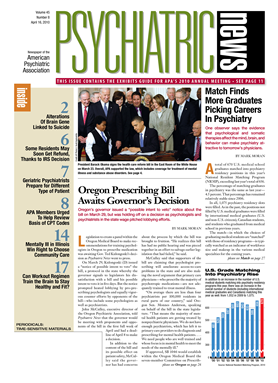Panic!
From an evolutionary point of view, panic can be a useful thing in moments of great danger. But when it occurs outside those times, it's a problem, and sometimes a very serious one, which accounts for the presence of panic disorder in DSM-IV.
We humans do a more considered job of reacting to intense danger than our more primal fellow creatures, explained Philip Johnson, Ph.D., an assistant research professor at the Institute of Psychiatric Research at the Indiana University School of Medicine.
Reptiles react quickly to danger, but mammals use their cerebral cortex to control their initial response, suppressing the reptile brain that lurks within, and acting less impulsively on their appetites and fears, said Johnson at the Anxiety Disorders Association of America annual conference in Baltimore in March.
Panic attacks in humans often appear spontaneous because they have no identifiable trigger when they occur, he said. They produce multiple physical symptoms with autonomic and behavioral components: sweating, increased heart rate and respiration, and higher blood pressure.
Johnson has been exploring animal models of panic attacks to discover biological systems that might cause or inhibit those attacks.
One path he and his colleagues have followed is gamma-aminobutyric acid (GABA). Decreased GABA in people with panic disorder may be a critical component.
“GABA serves as the brakes,” said Johnson. “It's dispersed into the brain until we need to panic; then it's inhibited, and we get the flight-or-fight response.”
Experimentally blocking GABA to the posterior hypothalamus engenders the same response. Inhibiting GABA leads to unconditioned anxiety and HPA mobilization, as well as increased heart rate and blood pressure.
With his colleague Anantha Shekhar, Johnson has begun using rat models to test the roles of various compounds in triggering or blocking panic attacks.
These rats show symptoms similar to the human version of the illness, by means of similar mechanisms (namely GABA deficits), and may eventually help identify potential therapies.
The current fast-acting treatment for panic attacks is benzodiazepines, but since GABAergic receptors are found throughout the body, these drugs cause side effects and operate in nonpanic moments, Johnson explained.
One experiment, using a corticotrophin releasing factor agonist, produced a “significant blockade of the panic response” without side effects such as sedation, amnesia, withdrawal symptoms, or hyper-prolactinemia, he said. Another approach may lie in orexin (or hypocretin).
“Orexin is produced in only one part of the brain, the dorsomedial-perifornical hypothalamus,” said Johnson. Neurons there with high levels of orexin play a critical role in key factors in panic, like arousal, vigilance, and mobilization of the central autonomic system. Orexin levels are higher in the cerebrospinal fluid of humans with panic anxiety than in control subjects.
Curiously, orexin knock-out mice behave a lot like people with narcolepsy do, he said. “Narcoleptics have a blunted response to CO2 challenge and so do orexin knock-out mice.”
Carbon dioxide at higher than normal concentration is one way of experimentally inducing panic in animals as well as in humans.
Rats whose orexin-synthesizing neurons are activated are also more prone to panic. Using orexin antagonists or silencing the gene that encodes orexin blocks the panic response.
In laboratory trials of some experimental agents, an orexin antagonist proved anxiolytic and attenuated panic attacks in rats challenged by sodium lactate, a standard agent for inducing panic.
Johnson's research results suggest that orexin plays a role in the pathophysiology of panic attacks and that orexin antagonists may someday be one means of treating panic disorder.

